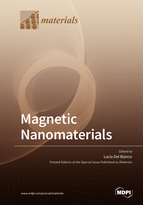Magnetic Nanomaterials
A special issue of Materials (ISSN 1996-1944). This special issue belongs to the section "Advanced Nanomaterials and Nanotechnology".
Deadline for manuscript submissions: closed (31 October 2021) | Viewed by 40760
Special Issue Editor
Special Issue Information
Dear Colleagues,
At present, the constant search for innovative magnetic materials is increasingly leading to the creation of highly engineered systems, built in different forms (films, dot arrays, nanoparticles, nanocrystalline alloys, etc.), structured on a nanometric scale in at least one spatial direction and often characterized by the coexistence of two or more phases, which are magnetically and/or structurally different.
The possible coincidence, at the nanoscale, of the typical size of the system with critical magnetic lengths ruling specific magnetic phenomena (for instance, the exchange length, below which a ferromagnetic element becomes single-domain, or the exchange correlation length, corresponding to the domain wall thickness) may cause the appearance of novel and amazing magnetic effects. Moreover, the magnetic behavior of nanomaterials can depend crucially on the structure and morphology of the constituent elements and on the type and strength of the magnetic interactions between them. Indeed, the study of the magnetic behavior of nanomaterials has not stopped attracting increasing interest because of their intriguing fundamental properties and prospective applications.
In this last respect, magnetic nanomaterials are already successfully employed or have the potential to play a key role in an extremely wide range of technologically advanced sectors: Energy, electric power technology, communications, spintronics, data storage, sensors, refrigeration, biotechnology, pharmacology, nanomedicine, and environmental protection.
This Special Issue is open to articles (reviews or original manuscripts) dealing with every aspect related to the creation and study, both experimental and theoretical, of magnetic nanomaterials. Particularly welcome are research works on innovative magnetic nanomaterials studied through an interdisciplinary approach and/or intended to be used in an interdisciplinary context.
Dr. Lucia Del Bianco
Guest Editor
Manuscript Submission Information
Manuscripts should be submitted online at www.mdpi.com by registering and logging in to this website. Once you are registered, click here to go to the submission form. Manuscripts can be submitted until the deadline. All submissions that pass pre-check are peer-reviewed. Accepted papers will be published continuously in the journal (as soon as accepted) and will be listed together on the special issue website. Research articles, review articles as well as short communications are invited. For planned papers, a title and short abstract (about 100 words) can be sent to the Editorial Office for announcement on this website.
Submitted manuscripts should not have been published previously, nor be under consideration for publication elsewhere (except conference proceedings papers). All manuscripts are thoroughly refereed through a single-blind peer-review process. A guide for authors and other relevant information for submission of manuscripts is available on the Instructions for Authors page. Materials is an international peer-reviewed open access semimonthly journal published by MDPI.
Please visit the Instructions for Authors page before submitting a manuscript. The Article Processing Charge (APC) for publication in this open access journal is 2600 CHF (Swiss Francs). Submitted papers should be well formatted and use good English. Authors may use MDPI's English editing service prior to publication or during author revisions.
Keywords
- Thin films and multilayers
- Dots and nanopatterned structures
- Nanoparticles and ferrofluids
- Nanocomposites and nanoalloys
- Hybrid (bio)-materials
- Biomimetic systems
Benefits of Publishing in a Special Issue
- Ease of navigation: Grouping papers by topic helps scholars navigate broad scope journals more efficiently.
- Greater discoverability: Special Issues support the reach and impact of scientific research. Articles in Special Issues are more discoverable and cited more frequently.
- Expansion of research network: Special Issues facilitate connections among authors, fostering scientific collaborations.
- External promotion: Articles in Special Issues are often promoted through the journal's social media, increasing their visibility.
- Reprint: MDPI Books provides the opportunity to republish successful Special Issues in book format, both online and in print.
Further information on MDPI's Special Issue policies can be found here.







